NCERT Solutions for Class 3 English Unit 3 - The Enormous Turnip
Page No 27:
Question 1: Learn New Words
A) Enormous
B) Turnip
C) Old man
D) Old woman
E) Pulled
Answer:
A) Enormous: very large in size Example sentences:
1) I saw an enormous animal in the zoo.
2) I got an enormous sum of money from my father.
B) Turnip: a round root with white or cream flesh Example sentences:
1) Turnips are slightly bitter to eat.
2) We had turnip today in dinner.
C) Old man: elderly male person Example sentences:
1) I helped the old man when he asked me for food.
2) The old man’s smile was very painful.
D) Old woman: elderly female person Example sentences:
1) I helped the old woman cross the road.
2) That old woman smiled at me.
E) Pulled: to move in a specific direction Example sentences:
1) He pulled me towards himself.
2) She pulled me down to sit on the chair.
Page No 28:
Question 1:
- What did the old man plant?
- Why was it difficult for the old man to pull up the turnip?
- Who helped him to pull up the enormous turnip?
- Who ate the enormous turnip?
Answer:
1) The old man planted some turnip seeds.
2) It was difficult for the old man to pull up the turnip, as it was enormous.
3) The old woman, the boy and the girl helped him to pull up the enormous turnip.
4) The old man, the old woman, the boy and the girl ate the enormous turnip.
Question 2: Name and draw four vegetables that have to be pulled out from the earth. Now name them in your own language. Answer:
Answer: Disclaimer: The names of the vegetables are also given in Hindi. The answer to this question may vary according to the mother tongue of the student.
Disclaimer: The names of the vegetables are also given in Hindi. The answer to this question may vary according to the mother tongue of the student.
Page No 29:
Question 1: Let’s go shopping!
How many vegetables can you find in this maze? Draw a circle around each word. One has been done for you.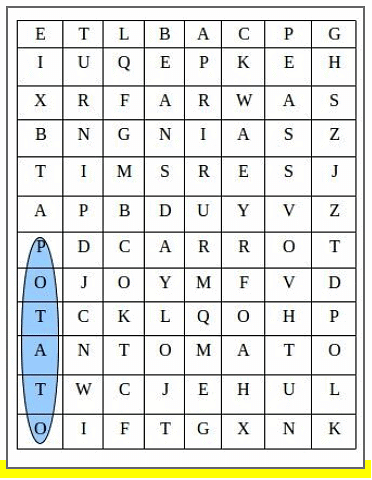 Answer:
Answer: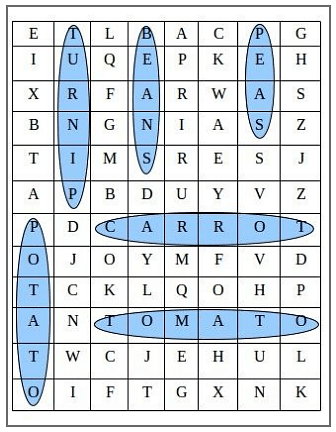
Page No 30:
Question 1: A Game of Opposites
The entire class can be divided into two groups where one group says one word and the second group says the opposite word. This is how the game goes on. Some words are suggested here. You may pick up some more words from the lesson.
This is how the game goes on. Some words are suggested here. You may pick up some more words from the lesson.
- Far
- Good
- Dark
- Up
- Old
Answer:
Disclaimer: These are sample answers. Students are advised to write the answers based on their own understanding and observation.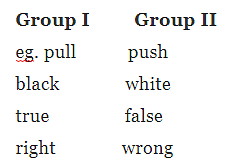
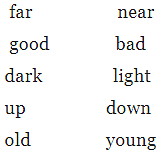
Question 2: Activity: Grow a plant Things required − A glass, blotting paper, some sand, some seeds of beans or rajma.
Method :
1. Line the blotting paper inside the glass.
2. Place the sand in the glass.
3. Wet the sand.
4. Place a few seeds between the blotting paper and the glass.
5. See that the seeds are separate from each other.
6. See how the roots and shoots of the seeds grow.
Make a Friendship Salad Things required − Carrots-2, Tomatoes-2, Peas-2 spoonfuls, Lemon-1.
Method:
1. Wash all the vegetables well.
2. Cut the carrots, tomatoes and lemon.
3. Mix the peas, carrots and tomatoes together.
4. Squeeze lemon juice on top.
5. Add salt.
6. Mix well.
7. Share your salad with your friends.
Answer:
Disclaimer: This is a creative activity to be done along with your friends and the guidance of your class teacher.
Page No 31:
Question 1: How do you like to eat these vegetables − raw or cooked? Say why.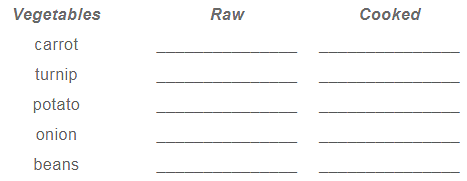 Name four vegetables you ate last week. Write their names here.
Name four vegetables you ate last week. Write their names here.
________ ________
________ ________
Complete these columns Answer:
Answer:
Disclaimer: These are sample answers. Students are advised to write the answers based on their own experience and observation.
I like to eat turnip, potato and beans after getting cooked as they become soft to eat after that.
I like to eat raw carrot and onion as they are good to eat and also with that I am able to eat proper nutrients in them.
| Vegetables | Raw | Cooked |
| carrot | ✔ | _______________ |
| turnip | _______________ | ✔ |
| potato | ______________ | ✔ |
| onion | ✔ | _______________ |
| beans | _______________ | ✔ |
- Spinach
- Jackfruit
- Cabbage
- Ladyfinger
| One | Many |
| carrot | carrots |
| turnip | turnips |
| onion | onions |
| potato | potatoes |
| tomato | tomatoes |
Page No 32:
Question 1: One word in each of the following sets is different from the others. Circle the odd one out.
i. turnip, potato, tomato, sunflower, carrot, brinjal (clue − vegetables)
ii. cow, horse, goat, fox, kangaroo, melon (clue − animals)
iii. banyan, neem, peepal, mango, snake, apple (clue − trees)
iv. rose, lily, sunflower, lotus, cauliflower (clue − flowers)
v. peacock, parrot, lizard, crow, woodpecker (clue − birds)
Answer:
i. turnip, potato, tomato, sunflower, carrot, brinjal
ii. cow, horse, goat, fox, kangaroo, melon
iii. banyan, neem, peepal, mango, snake, apple
iv. rose, lily, sunflower, lotus, cauliflower
v. peacock, parrot, lizard, crow, woodpecker
Question 2: Let's read and write Answer:
Answer:
|
23 videos|151 docs|45 tests
|
FAQs on NCERT Solutions for Class 3 English Unit 3 - The Enormous Turnip
| 1. What is the story of "The Enormous Turnip" about? |  |
| 2. Which book contains the story "The Enormous Turnip"? |  |
| 3. What are the moral lessons taught by "The Enormous Turnip"? |  |
| 4. How can "The Enormous Turnip" story be used for teaching children? |  |
| 5. Are there any adaptations or variations of "The Enormous Turnip" story available? |  |

|
Explore Courses for Class 3 exam
|

|


















